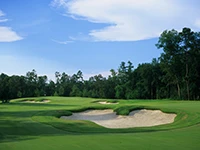
Stunting grass growth in the summer heat can be a pain, but sticking to a PGR spraying schedule provides a strong program to prevent rebound growth.
PGRs make superintendents’ job of maintaining grass easier. But once PGRs have worn out and aren’t reapplied, rebound occurs, leaving superintendents with a lot of nightmarish work ahead. Most veteran superintendents have developed a routine when it comes to applying PGRs to keep rebound at bay, or at least know when it will strike.
But it’s not as simple as just spraying PGRs. It’s a scheduled and calculated task that varies from course to course. Experience and experimenting is how superintendents figure out what works with their turf.
Brian Martell, superintendent of Walnut Creek Country Club in Mansfield, Texas, follows a timely schedule to keep his turf from rebounding.
Bud White, superintendent of Carlton Woods in The Woodlands, Texas, swears by a different method. “We apply on a strict calendar basis until the heat of summer and then we go to the Degree Day Model,” he says. “For example, we started this week applying PGRs twice a week to greens versus once a week because the DD model calls for that.”
White has experimented with other approaches with PGR, but the Degree Day Model has been the most successful for him. “This program is our best so far on materials and timing,” he says.
Martell’s method of increasing spraying rates works for his turf, but it's different than the way White manages his course. “Increasing rate is not the answer. It is a timing issue in relation to heat,” he says. Timing in correlation to temperature is why White prefers the Degree Day Model. “Use the DD model. It is accurate and it works. Too many rate increases and this is futile.”
Following the Degree Day Model, White has specific PGR rates he uses for the different grass types. White uses 4 oz per week of Primo on TifEagle greens in season and 10 oz per 3 weeks on Zeon zoysia tees and fairways. He uses 12 oz of Legacy per acre every 3 weeks on Tifway tees and fairways.
Both superintendents agree that sticking to a schedule with whichever method or PGR of choice is the best way to prevent rebound. White’s rookie mistake was “Trying to stretch timings too far,” he says. Martell encourages other superintendents to “Make sure you spray in shorter intervals. I go a week before they say you should to get control.”
Martell’s increasing spraying rates has been effective for him during the summer, but he is always looking for newer and better PGRs to try. “I’m going to try Anuew later this summer. When I spray my greens in the summer, I would like them not to grow.”
Latest from Golf Course Industry
- Carolinas GCSA raises nearly $300,000 for research
- Advanced Turf Solutions’ Scott Lund expands role
- South Carolina’s Tidewater Golf Club completes renovation project
- SePRO to host webinar on plant growth regulators
- Turfco introduces riding applicator
- From the publisher’s pen: The golf guilt trip
- Bob Farren lands Carolinas GCSA highest honor
- Architect Brian Curley breaks ground on new First Tee venue






